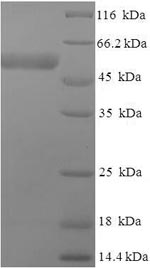Recombinant Human Isocitrate dehydrogenase [NAD] subunit gamma, mitochondrial (IDH3G) is produced in E. coli and represents the full-length mature protein from amino acids 40 to 393. The protein carries an N-terminal 6xHis-SUMO tag, which makes purification and detection more straightforward. SDS-PAGE analysis shows purity levels exceeding 90%, indicating the material should be suitable for research applications.
Isocitrate dehydrogenase [NAD] subunit gamma appears to be a crucial component of the mitochondrial enzyme complex that drives the citric acid cycle—a fundamental metabolic pathway. The protein helps catalyze the oxidative decarboxylation of isocitrate, which contributes to energy production through NADH generation. Given its role in cellular respiration, IDH3G has become a significant focus in metabolic research.
Potential Applications
Note: The applications listed below are based on what we know about this protein's biological functions, published research, and experience from experts in the field. However, we haven't fully tested all of these applications ourselves yet. We'd recommend running some preliminary tests first to make sure they work for your specific research goals.
The human IDH3G is a subunit of the mitochondrial NAD-dependent isocitrate dehydrogenase complex (IDH3), which requires correct folding, assembly with IDH3A and IDH3B subunits, and potential cofactor binding for bioactivity. E. coli expression may facilitate soluble production due to the SUMO tag, but as a prokaryotic system, it lacks mitochondrial chaperones and post-translational modifications needed for optimal folding of eukaryotic metabolic enzymes. The SUMO tag could improve folding but may sterically hinder inter-subunit interactions. While the high purity suggests minimal impurities, correct folding and bioactivity cannot be assumed without validation (e.g., circular dichroism for structure or enzyme assays for complex activity). Therefore, the protein may be misfolded or inactive, and experimental confirmation is essential before functional use.
1. Protein-Protein Interaction Studies
If the recombinant IDH3G is verified to be correctly folded (e.g., through biophysical assays), it could be used to study interactions with IDH3A and IDH3B subunits via pull-down or co-immunoprecipitation. The His tag facilitates immobilization. However, if misfolded, interaction results may be unreliable due to altered binding sites or tag-mediated artifacts. Validation with native complexes from eukaryotic sources is recommended for physiological relevance.
2. Antibody Development and Validation
This recombinant IDH3G can serve as an immunogen for antibody production, as antibodies often recognize linear epitopes even in misfolded proteins. The high purity supports consistent immunization and screening. However, antibodies generated may not bind native IDH3G in mitochondrial complexes due to conformational differences. Specificity should be validated against eukaryotic-expressed IDH3G for applications like Western blot or immunofluorescence.
3. Structural and Biophysical Characterization
The protein is suitable for basic biophysical analyses (e.g., circular dichroism to assess secondary structure, dynamic light scattering to monitor aggregation) to evaluate folding status. However, correct folding is critical for high-resolution structural studies (e.g., X-ray crystallography). A misfolded protein or the SUMO tag may interfere with data interpretation. Tag removal is advised for meaningful structural insights.
4. Biochemical Assays for Complex Assembly
This application requires a correctly folded and functional IDH3G for valid results. If the protein is bioactive (verified through complex reconstitution assays), it could be used to study assembly with IDH3A and IDH3B. However, if misfolded, assembly may fail, leading to false negatives. Pre-validation of enzyme activity or subunit binding is necessary before such experiments.
Final Recommendation & Action Plan
Before using this recombinant IDH3G for any functional application, prioritize experimental validation of its folding and bioactivity. Start with biophysical assays (e.g., circular dichroism to check for expected secondary structure elements, size-exclusion chromatography to assess oligomerization) and functional tests (e.g., in vitro complex reconstitution with IDH3A and IDH3B to measure enzyme activity). If activity is confirmed, proceed with interaction or structural studies; otherwise, limit use to non-functional applications like antibody production, but always validate outcomes with native IDH3G. For reliable results, consider expressing IDH3G in a eukaryotic system (e.g., yeast or mammalian cells) to ensure proper folding and complex assembly. Avoid functional assays without prior activity confirmation.






